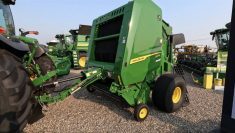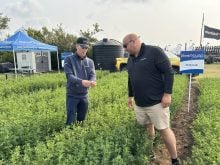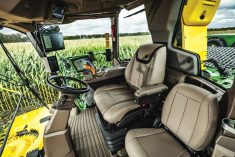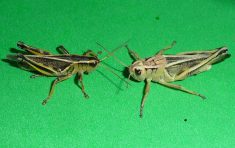LOUISVILLE, Ken. — Vermeer has taken its high capacity wheel rake system and suspended it in a good way.
Large wheel rakes typically keep pressure in the ground using spring systems, the weight of the disc and machine or offsetting weight distributed from a neighbouring disc via a shared or tandem axle carrier. In most cases, a combination of processes put the teeth in contact with the field’s surface.
Vermeer staff found the variation in the ground’s surface magnified the pressure on the rake tines, causing excessive wear and soil contact and uneven raking while windrowing forage and corn stover.
Read Also

More work wanted on removing red tape
REGINA — Canadian farmers risk falling further behind competitors if two main federal agencies don’t become more efficient and responsive…
Philip Egging of Vermeer in Pella, Iowa, said the company decided to look at other ways to keep pressure on the rake wheels.
What the company came up with won it recognition from the American Society of Agricultural and Biological Engineers this year.
The VR1428 High Capacity Wheel Rake was awarded an AE50 by ASABE at its Louisville meeting in February for creating a rake wheel suspension on each disc, dampening its movement and maintaining continuous pressure across uneven ground and in variable amounts of forage or crop residue.
Each raking wheel has its own hydraulic lift cylinder that raises and lowers the unit. The wheels are plumbed into a central system that contains a nitrogen-charged accumulator. This provides constant pressure on the wheel through its full range of motion.
“You don’t have the pressure on the wheel rising dramatically as the wheel moves up. If it were mounted to a spring, the spring’s force would rise as it stretched,” he said.
The pressure the system applies is set by attaching the rake’s hydraulic system to the tractor and adding pressure. The pressure is captured with a hand-controlled valve on the rake and then it is adjusted to the desired level by observing a gauge on the machine.
“No tools needed. No more pushrods and chains,” he said.
“One of the benefits that we might not have anticipated is how much quieter the rake runs than other, older models. That noise was the teeth on the ground. That is where the wear came from,” said Egging.
While the company was at it, the way previous models transferred the pull from the tractor to the folding toolbar was changed through the addition of a three axis of rotation linkage between the centre and wing sections.
“It eliminated the torsion on the large (28 foot wide) rake’s (toolbars). We have seen the two axis machines break under heavy use, so this put the load on the (hitch section) instead,” he said.
A new centre cleaner set of rakes were created, using full-sized, 54 inch wheels, rather than the typical smaller wheels that have a tendency to wrap in long grass.
Those tines on those rakes are bent at a more extreme angle than on the main wheels.
“This new rake feeds more smoothly than anything I’ve ever seen, its quiet and there’s nothing left behind. Any hey, we got an engineering award for it, so we’re pretty pleased,” said Egging.
The VR1428 has a list price of U.S. $24,900. For more visit www.vermeer.com or for more on the AE50s visit www.asabe.org.

















